Oslo, Norway



June 11 - 14, 2024
We left home and flew to Copenhagen, where we transferred to another flight to Oslo. The travel time was about 16 hours and a distance of 5,809 miles. Here is a map showing the route over Greenland.

We took a taxi ride from the airport to central Oslo, utilizing a spiffy machine at the airport which offered a fixed price. The ride took about 45 minutes. We ate dinner in the hotel’s restaurant and then went to bed!
Thursday, June 13, 2024
This morning we walked to the Oslo City Hall, a brick building with tall towers constructed beginning in 1931 and not completed until 1950. Former Oslo mayor Hieronymus Heyerdahl proposed in 1915 to build the new City Hall in Pipervika district - at the time a slum district. In 1918, architects Arnstein Arneberg and Magnus Poulsson won the architectural competition to design the proposed City Hall. The end result from 1930 testifies to the various trends that characterized the architecture of the era.


One City Hall Tower did not have scaffolding.
Unfortunately, the outside of the building (one of its towers and two sides) were covered in white plastic. The large hall inside (where the Nobel Peace Prize dinner is held) was full of frescoes on all walls. We went up the stairs to the second floor, from which we could appreciate the main floor’s design. A few other rooms were open including one featuring a Munch painting. Many other rooms were closed setting up for private events. We found the city hall similar to the one we visited in Stockholm last year, although the mosaics in the latter were more impressive. Both buildings were worth visiting.

Above photos shows the rear façade.
Below, three photos from the inside.

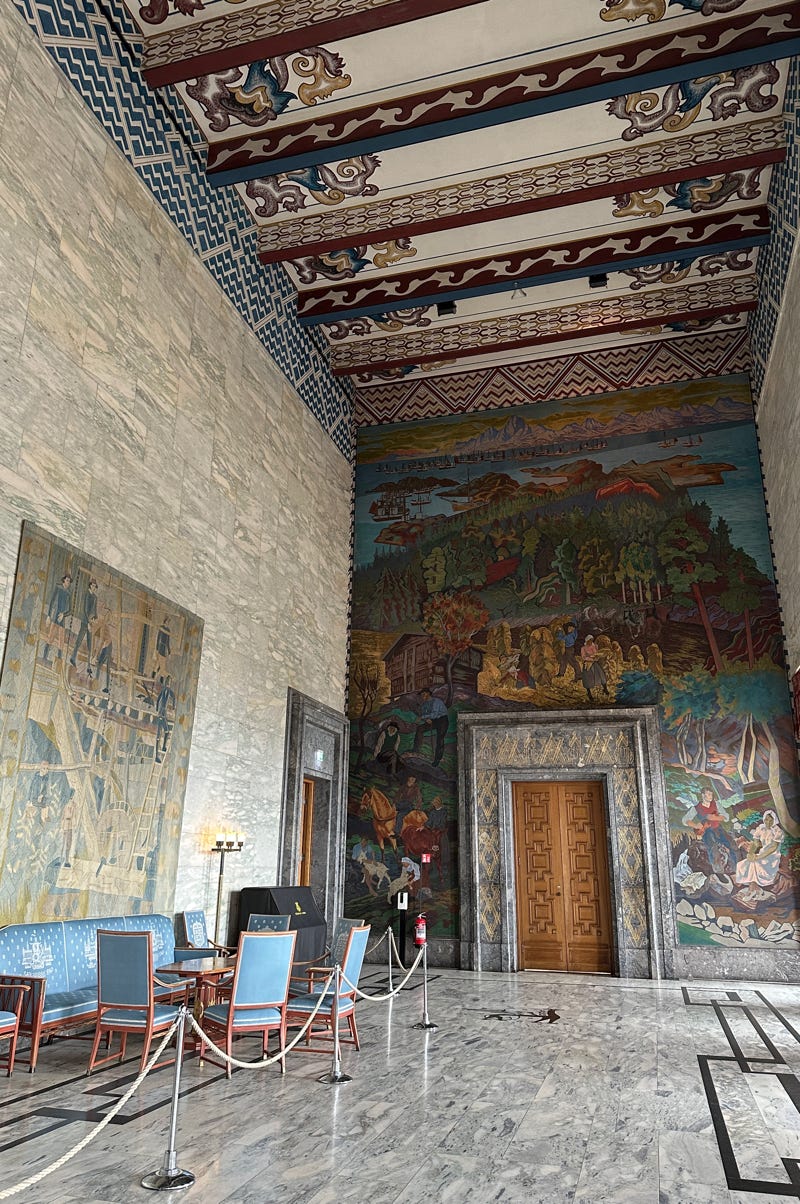

After that, we walked two blocks to the fairly new National Museum of Norway, a large, modern building. Actually, the museum is not new, but the building is and various collections were consolidated there. There were three floors of exhibits; the second floor featured European painting from the late medieval period through the 20th century. Norwegian artists were featured, including Dahl, Fearnley and Munch. Munch’s original version of the painting colloquially known as “The Scream” is the museum’s most famous painting. Munch painted several other versions, and we might visit the Munch Museum tomorrow, if time permits.
The third floor of the museum features an exhibit of works by Mark Rothko, who was born in Latvia but is mostly recognized as an American artist. We were surprised that early works from his career were not the colorful geometric canvases with which he is mostly associated. We enjoyed this special exhibit. The ground floor of the museum exhibited sculptures and decorative arts, as well as Scandinavian design from the late 19th through the late 20th centuries.

The museum exterior, above, and works of art, below.
The “Scream”, a Rothko painting and a display of design.



We had lunch in the Museum’s attractive cafe on the ground floor and then walked over to the neighboring Nobel Peace Center. We were treated to information about Peace Prize winners going back over a century, and saw some photos of prize ceremonies in the City Hall. There were some special exhibits, including one commemorating the most recent honoree (Narges Mohammadi) as well as a retrospective on Yoko Ono’s works. We found the Peace Center quite moving.

The area outside the Peace Center and the National Museum of Norway faces the harbor and the Akershus Fortress can be seen in the distance. There were six food trucks and a good crowd of people walking around near the harbor. We then walked back through central Oslo to our hotel for a brief rest to deal with jet-lag before heading back out later in the afternoon.

View of the fortress. We never made time to visit it. Next time!
After recharging our phone batteries, we headed back out and walked about ten minutes on Grensen, a main street, to the Dom Kirke, the city’s cathedral. The church dates from the late 17th century, having been remodeled in 1850. It boasts 20th century ceiling paintings and stained glass windows by Emanuel Vigeland. We didn’t know if we’d have time to see the cathedral, but it was a nice surprise.
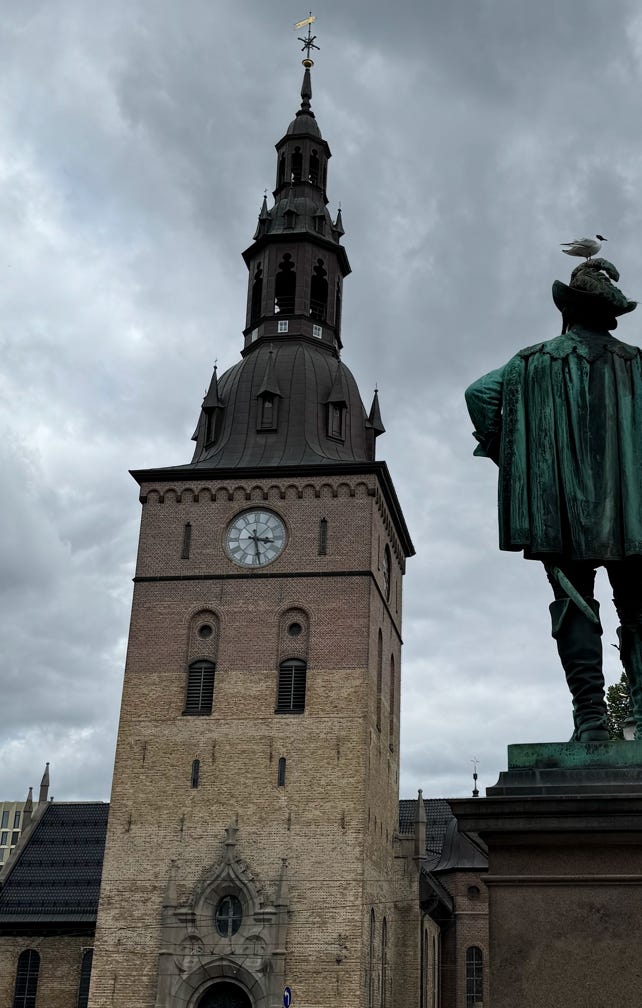

Cathedral tower to the left (included to show the bird on the statue’s head. We never saw at statue without one, see photo from palace at top of page). Ceiling detail to the right; better photo of the tower, below.

We then walked to the Museum of Cultural History, located not far from our hotel in a Neo- Romanesque building. Many of the exhibits were being switched out, but we saw a good collection of Viking treasures, Norse medieval historical items, ancient statuary from the Crusades and some impressive wood pieces saved from stave churches that were to be demolished. Most impressive was an intact ceiling from the Ål Stave Church.
Then we walked uphill in a park to get a view of the Royal Palace. From there we walked down Karl Johans Gate, which has an attractive tree covered esplanade, and is the main boulevard of central Oslo.
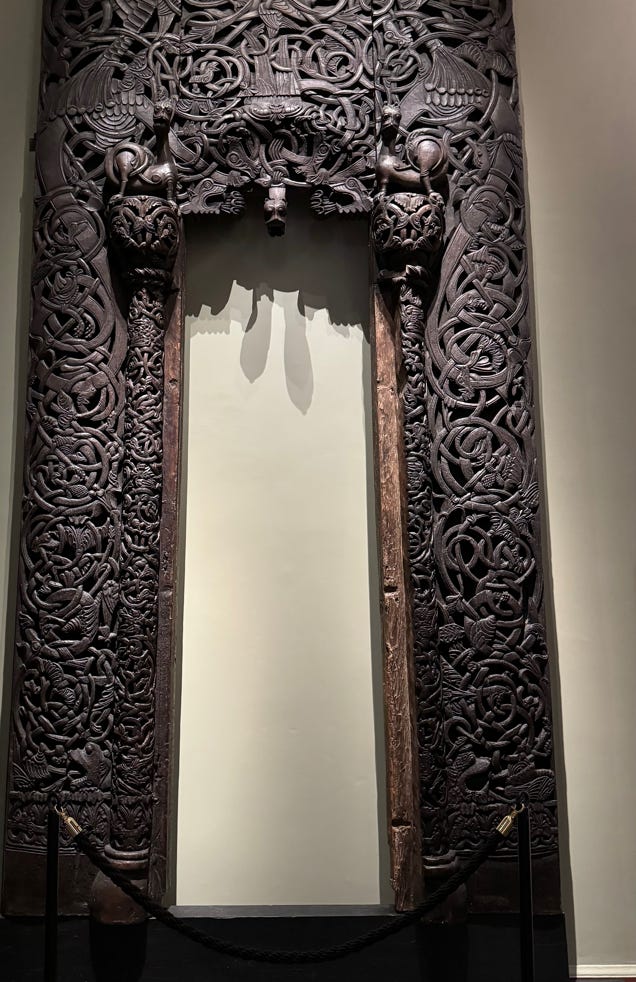
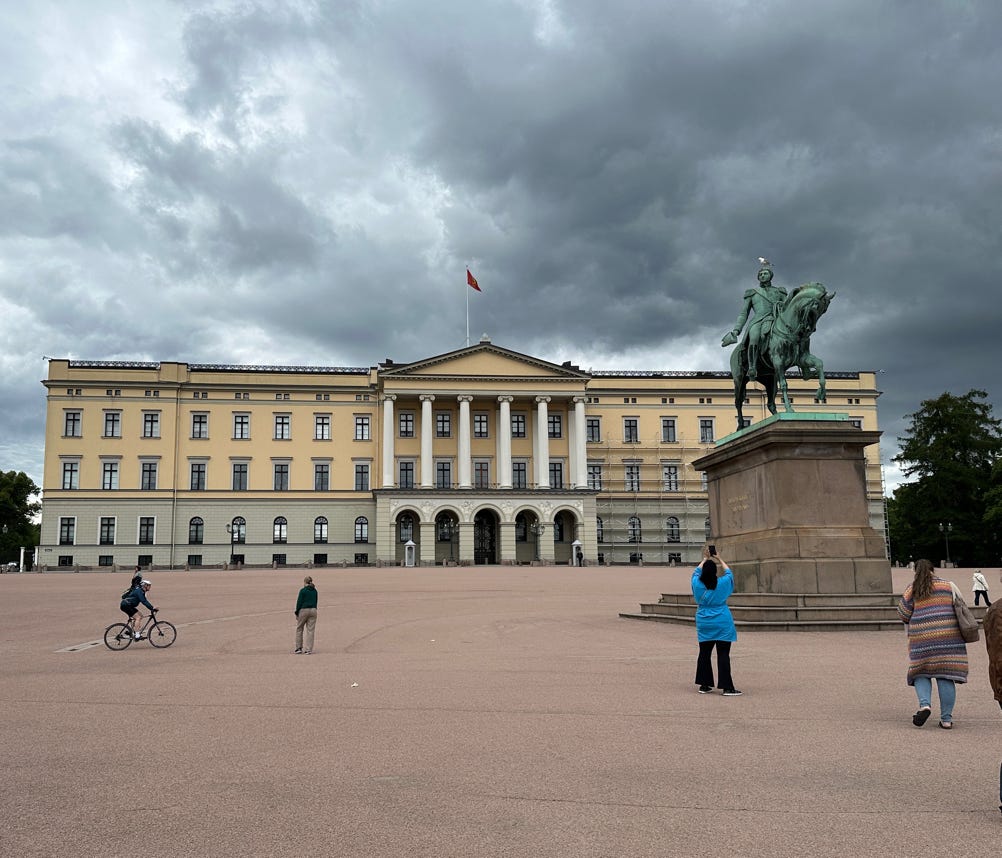
Carving from the Ål Stave Church, left, palace above (note the bird), and a view down Karl Johans Gate, below.
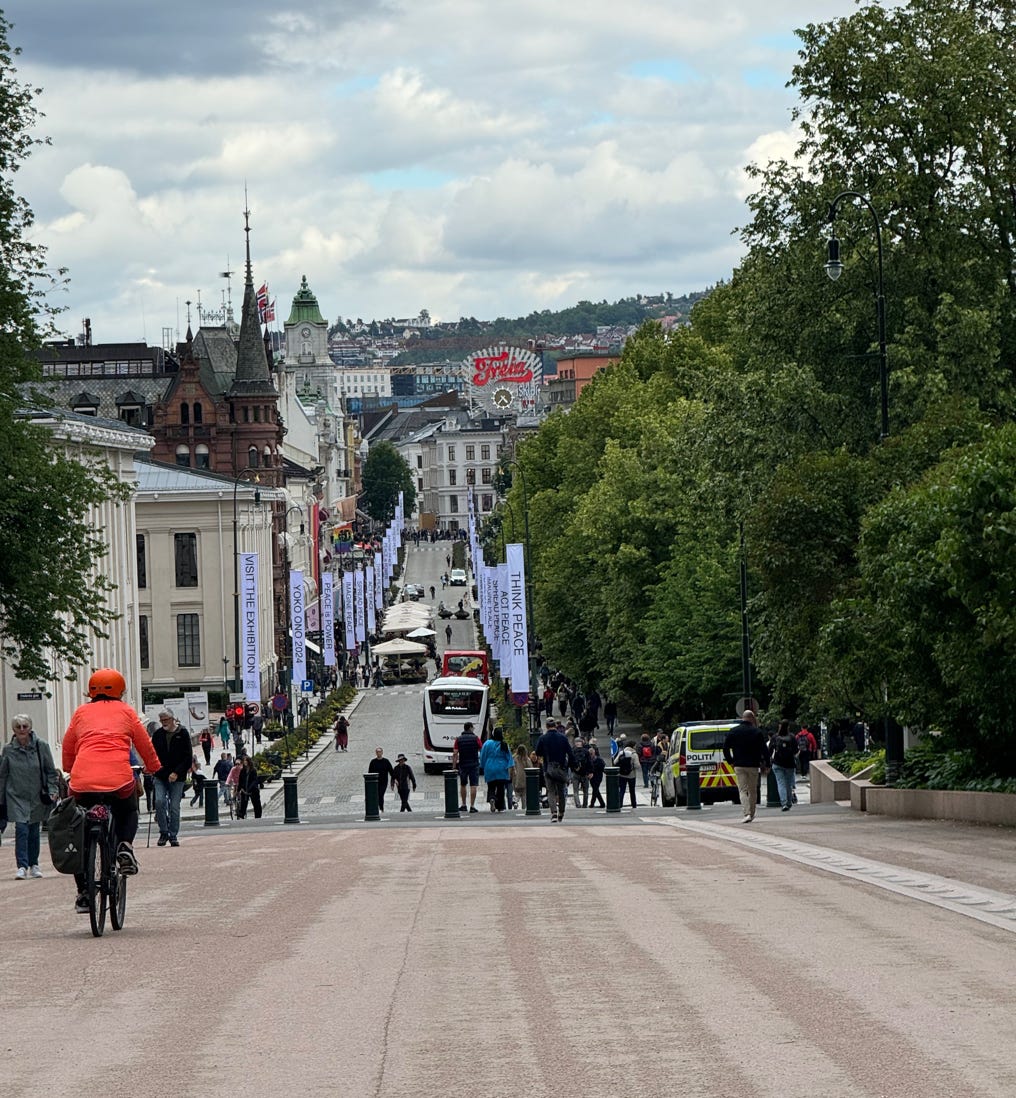
Today we walked over seven and a half miles!
Friday, June 14, 2024
Today we took a bus from our central Oslo hotel to the Bygdoy Peninsula, where several museums are located.
The first museum we visited was the Fram Museum, which chronicled the explorations of the Arctic and Antarctic by Norwegians. Containing the actual Fram and Gjøa ships, the museum explained the story of how Roald Amundsen navigated the Northwest Passage and won the race to the South Pole. The museum had this tidbit of information: “Fridtjof Nansen’s plan deliberately to let a ship freeze into the dreaded ice in the Arctic Ocean was revolutionary. The idea was thought to be suicidal as no ship could withstand the ice pressure. The Fram proved this wrong, but then the construction was exceptional. The main innovation was the rounded hull with smooth sides so the ice could not get a grip to press the ship down, but on the contrary would press it upwards like a round nut squeezed between two fingers. The wooden materials were stronger, thicker and more closely spaced than on any ship before. The rudder and propeller could be hoisted up inside a well in the stern to protect them from ice damage, and the ship was short, for maneuverability in the ice as well as for extra strength.” Nansen was Amundsen’s most important advisor and instrumental in both his Arctic and Antarctic expeditions.

The Fram was difficult to get in a photo. Above was taken on the top
deck. Below is a photo of the Gjøa.
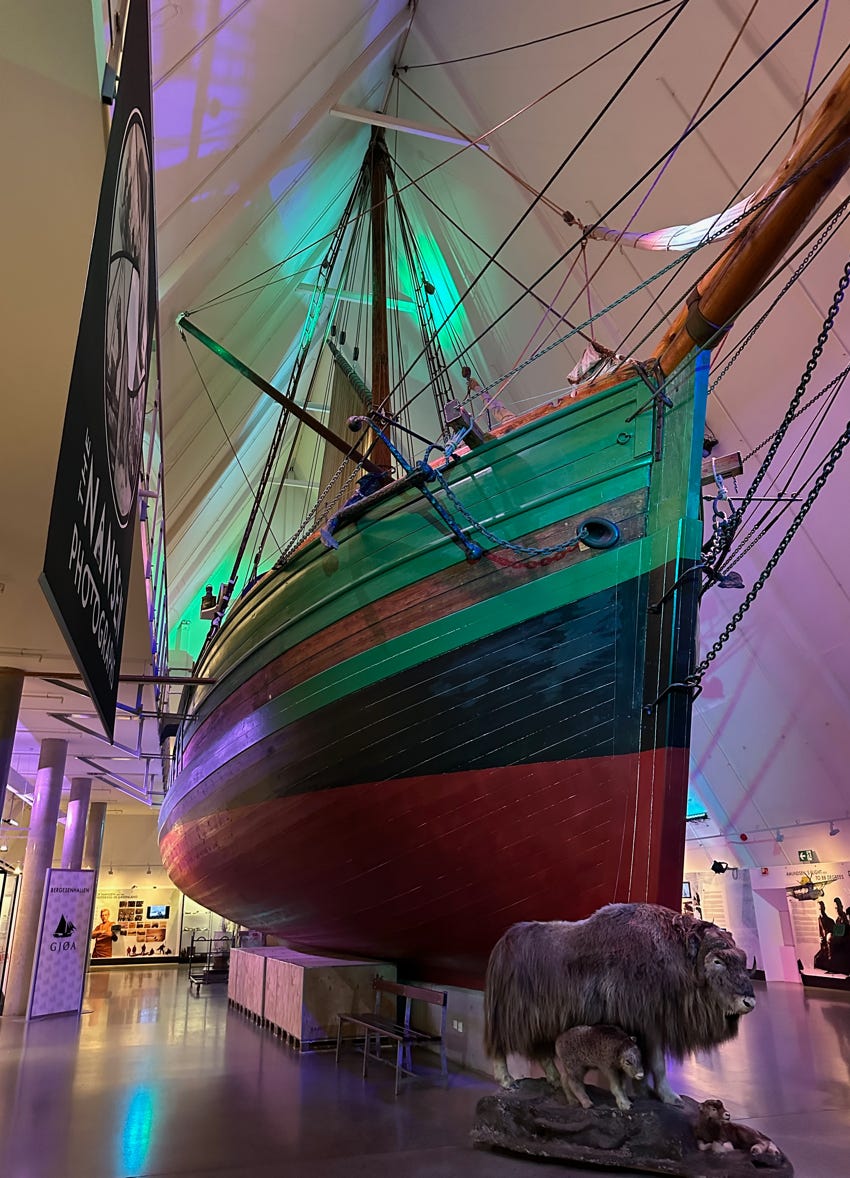
We watched an interesting film and saw footage from the Antarctic Expedition. We then crossed the street to the Kon–Tiki Museum. This museum displays two rafts used by adventurer Thor Heyerdahl. The Kon–Tiki raft was sailed from Peru to Polynesia in 1947, to prove such a crossing was possible on a large balsa wood raft. The second raft, made of reeds, traveled from Barbados to Africa in 1970. This is the introductory text at the museum: “In the spring of 1947, six men embarked on an expedition with all odds against them. Their vessel had never been tested, and it had several potentially dangerous flaws. The theory claiming that the expedition was safe was considered controversial at best. If anything went wrong, the crew would be drifting helplessly in some of the world’s most turbulent waters, beyond help of any kind. The leader, 33-year-old Norwegian Thor Heyerdahl, suffered from severe hydrophobia, had minimal swimming skills, and had no experience as a sailor whatsoever. This is the story about him, and why he and five other men - succeeded on a journey, which most experts had predicted failure and certain death.”

The Kon-Tiki raft.
We found both of these museums well done and interesting.
We then rode a bus to the Norsk Folkemuseum. This museum is another “open air” museum featuring historic structures. The outdoor section of the museum has 150 buildings from different regions of Norway covering a period of over 400 years. Among them is a stave church from the town of Gol (through which we will drive tomorrow), built in 1212 and reconstructed here. Inside the church are wood paintings from 1452. We found this museum’s atmosphere less “Disney-fied” than the one we visited in Stockholm last year, although both were worthwhile.

Three photos from the folk museum, including the stave church. We learned that the roof at the right, which we referred to as boing covered with sod, is actually called “thatched”.


After having lunch in the museum’s cafe, we took a bus across Oslo to the impressive, modern Opera House which opened in 2008. The Opera House is clad in gleaming white marble, and features a sloped roof which allows people to walk up to and on the roof. There are panoramic views of the harbor and the city from the roof. The foyer features a blond wood frieze (the “waving wood wall”). From the roof terrace of the Opera House, we could see the nearby Munch Museum. We had seen a lot of Munch’s work yesterday, so we decided to move on. The entire area around the Opera House contains a modern redevelopment and much public art. Here are several photos.

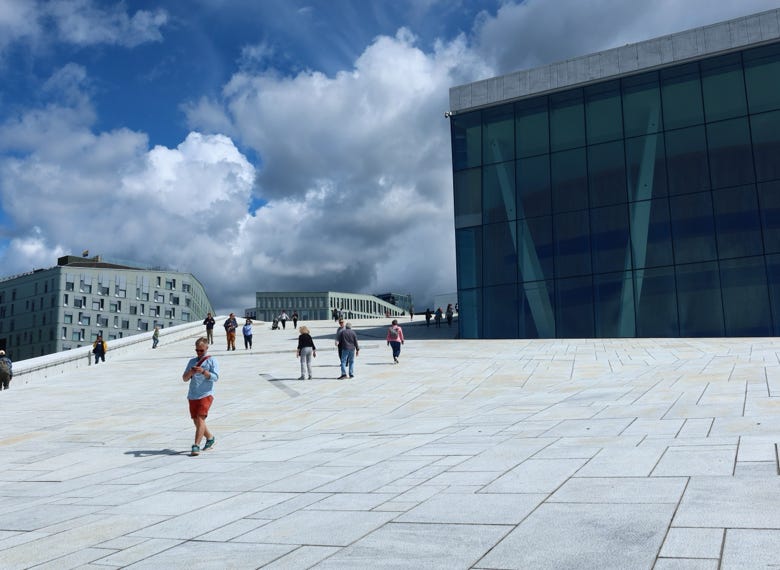

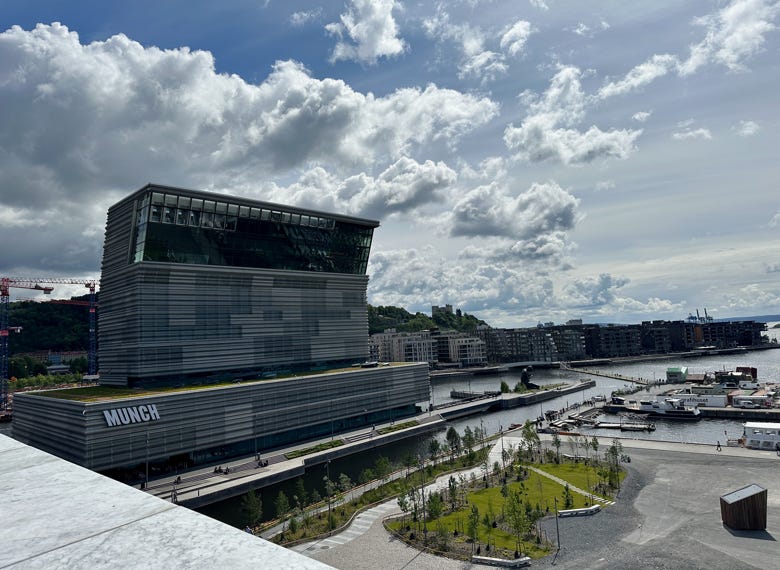


We then took a bus to another part of the city that features a redevelopment, the Fjordbyen that was constructed around Aker Brygge, a harbor front renewal project. After wandering through the apartments and other newer buildings, we visited the wood clad, glass-roofed Astrup Fernley Museum of Contemporary Art.
We then strolled along the edge of the harbor, with its nice view of the medieval Fortress and passed the Nobel Center we visited yesterday, where we caught a streetcar back to our hotel and relaxed at a nearby pub.


Above are two final photos of Oslo, the first showing attractive square with Parliament, which we walked through several times, and the second a typical street near our hotel.
Here is a map showing many of the locations we visited in Oslo
Tomorrow, we will be leaving Oslo and heading to Norway’s western fjords.
